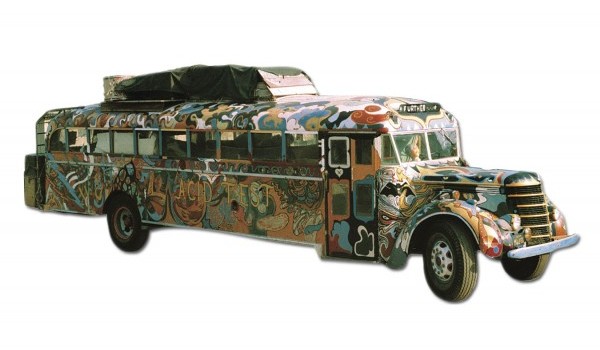In the 60s
In 1964, Ken Kesey and his group of “Merry Pranksters,” fueled by LSD and a free-wheeling spirit of adventure, painted a 1939 International Harvester school bus in DayGlo colors and piloted it across the US on a trip that would go down in history as a cultural milestone. The bus, dubbed “Further” (or “Furthur,” varying by day and mood), was purchased largely with Ken’s earnings from the publication of his best-selling novel, One Flew Over the Cuckoo’s Nest. Tom Wolfe’s popular 1968 account of the trip and the bus, The Electric Kool-Aid Acid Test, would go on to cement Furthur and the Pranksters as cultural icons signaling broad changes in American society.
What it Represents
More than any other work of art, the bus represents the sweeping changes that came over the country in the 60s. As people began to question traditional values and means of expression, Furthur stood as a highly visible representation of a new brand of American freedom. In a highly positive and meaningful way, its whimsical character became a metaphor for a new brand of psychedelic exploration. While the Pranksters, themselves, bridged the gap between the Beats and Hippies, the bus was a physical manifestation of the idea of a psychedelic trip.
Furthur’s Decline
By the late 1960s, the original Furthur began to fall into disrepair. By that time, Ken had returned to Oregon, where he raised his family, continued to write, and taught at the University of Oregon. While a second version of Furthur (not “Furthur 2”) was created in the late 1980s, the original bus was resigned to the “swamp,” a wet, low-lying area behind the Kesey family farm. Overgrown by weeds and surrendered to the wild, the bus remained in the swamp till October 2005, when a group of about 30 Pranksters, family, and devoted fans cut away the blackberry vines and trees that had overtaken it and pulled it free. During its time unprotected in the outdoors, Furthur largely rusted away. The interior rotted, and the once-beautiful exterior art faded nearly completely away.
Let’s Bring it Back
Following its initial rescue in 2005, the bus has been safely secluded away in covered storage. Lacking the significant funding necessary to rebuild it and restore its art, it has continued to slowly rust. With your generous donations, and the help of highly qualified restoration experts and artists, we hope to soon return the bus to its 1964 splendor, and preserve this important and inspirational artifact to inspire future generations as has inspired so many others.
Learn More
Further (bus), Wikipedia
Magical Mystery Tour, Smithsonian.com

